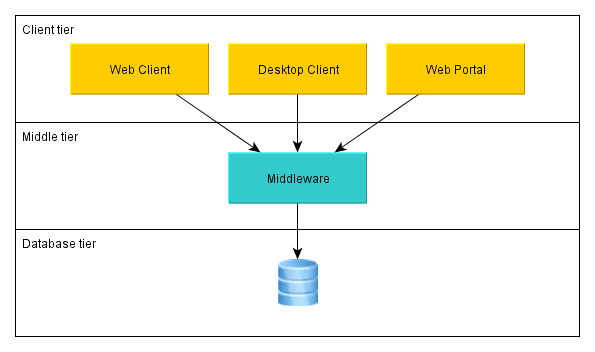4.1.1. Application Tiers and Blocks
The platform enables building applications according to the classic three-tier pattern: client tier, middleware tier, database. The tier indicates the degree of "remoteness" from the stored data.
Further on, mainly middleware and client tiers will be described, therefore the words "all tiers" will refer to these tiers only.
Each tier enables creating one or more application blocks. A block is a separate executable program interacting with other blocks in the application. CUBA platform tools enable creation of blocks in the form of web or desktop applications. Development for mobile platforms currently remains beyond CUBA framework; however, mobile blocks made up using other tools can be integrated with the standard blocks of the application.

- Middleware
-
The middle tier contains core business logic of the application and provides access to the database. It is represented by a separate web application running on Java EE Web Profile standard container. See Middleware Components.
- Web Client
-
The main block of the client tier. It contains the interface designed primarily for internal users. It is represented by a separate web application running on Java EE Web Profile standard container. The user interface is implemented on the base of Vaadin framework. See Generic User Interface.
- Desktop Client
-
The additional block of the client tier. It contains the interface designed primarily for internal users. It is represented by a desktop Java application; the user interface is implemented on the base of Java Swing framework. See Generic User Interface.
- Web Portal
-
The additional block of the client tier. It contains the interface for external users and integration tools for mobile devices and third-party applications. It is represented by a separate web application running under Java EE Web Profile standard container. The user interface is implemented on the base of Spring MVC framework. See Portal Components.
Middleware is the mandatory block for any application. User interface is generally implemented by one or several blocks, such as Web Client and Web Portal.
The above mentioned blocks are standard, however, in order to separate the functionality in a complex application one can easily create any number of client blocks as well as middleware blocks.
All of the client blocks interact with the middle tier uniformly via HTTP protocol enabling to place the middle tier arbitrarily, behind firewall as well. It is worth mentioning, that in the simplest case when the middle tier and the web client are deployed on the same server local interaction between them can bypass the network stack in order to reduce overhead.